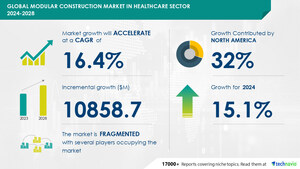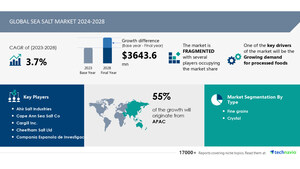NEW YORK, May 13, 2024 /PRNewswire/ -- The global neurostimulation devices market size is estimated to grow by USD 6.26 bn from 2023-2027, according to Technavio. The market is estimated to grow at a CAGR of about 12.19% during the forecast period.
For more insights on the forecast market size and historic data (2017 - 2021) - Buy Report
Forecast period |
2023-2027 |
Growth momentum & CAGR |
Accelerate at a CAGR of 12.19% |
Market growth 2023-2027 |
USD 6.26 billion |
Market structure |
Fragmented |
YoY growth 2022-2023 (%) |
10.4 |
Regional analysis |
North America, Europe, Asia, and Rest of World (ROW) |
Performing market contribution |
North America at 40% |
Key countries |
US, Germany, UK, Japan, and China |
Key companies profiled |
Abbott Laboratories, ALEVA NEUROTHERAPEUTICS SA, Axonics Inc., Bayer AG, Bioinduction Ltd, Boston Scientific Corp., electroCore Inc., EndoStim Inc, Integer Holdings Corp., LABORIE MEDICAL TECHNOLOGIES CORP., LivaNova Plc, Medtronic Plc, NeuroMetrix Inc., NEURONETICS Inc., NeuroPace Inc., Nevro Corp., Parasym, Perflow Medical Ltd., Soterix Medical Inc., and Synapse Biomedical Inc. |
Market Driver
Neurostimulation devices, including deep brain stimulators, spinal cord stimulators, sacral nerve stimulators, vagus nerve stimulators, and transcutaneous electrical nerve stimulation (TENS) units, are gaining approval for various indications and undergoing clinical trials. These implantable medical devices, used for neuromodulation and neurostimulation, have shown promise in treating chronic conditions such as neuropathic pain, essential tremors, dystonia, gastroparesis, and orthopedic degenerative disorders. Neurostimulation offers a potential solution for patients with unrelenting pain from neurodegenerative diseases like Alzheimer's and Parkinson's (PD), stroke, and neurological disorders. Key players in the market include Abbott with their Proclaim DRG Neurostimulator System, Neuspera Medical, and others. Indications include chronic pain, migraine, epilepsy, and essential tremors.
Market Challenges
- Neurostimulation devices, a segment of implantable medical technology, offer neuromodulation for various neurological and chronic conditions. These devices, including PD pumps, Deep Brain Stimulation (DBS) systems, Sacral Nerve Stimulation (SNS), Vagus Nerve Stimulation (VNS), and Gastric Electrical Systems, carry significant costs. In the US, DBS surgery averages USD65,000, while bilateral procedures range from USD70,000 to USD100,000. An SNS system costs approximately USD18,000, and a VNS device and lead implantation cost between USD25,000 and USD30,000. Post-operative expenses, such as battery replacement for DBS therapy (USD10,000-USD20,000), add to the overall cost. Neurostimulation devices target neurological disorders, nerve injuries, and conditions like Alzheimer's, Parkinson's, and epilepsy. Reimbursement, regulatory approval, and healthcare provider collaboration are crucial factors in their adoption, particularly in emerging countries.
Research report provides comprehensive data on impact of trend, driver and challenges - Request a sample report!
Segment Overview
This neurostimulation devices market report extensively covers market segmentation by
- Application
- 1.1 Pain management
- 1.2 Urinary and fecal incontinence
- 1.3 Parkinsons disease
- 1.4 Epilepsy
- 1.5 Others
- Product
- 2.1 Implantable neurostimulation devices
- 2.2 External neurostimulation devices
- Geography
- 3.1 North America
- 3.2 Europe
- 3.3 Asia
- 3.4 Rest of World (ROW)
1.1 Pain management- The Neurostimulation Devices Market encompasses a broad range of technologies, including those used for Parkinson's and Alzheimer's disease treatment. Regulatory approval processes are essential for bringing these neurotech devices to market. Internal neuromodulation, such as deep brain stimulators, and external neuromodulation, like Transcutaneous Electrical Nerve Stimulation (TENS), are two primary categories. Gastric electrical stimulation and transcranial magnetic stimulation are other neurostimulation techniques used for various indications, including gastroparesis and neurovascular disorders. Neurovascular embolization and surgical procedures are often necessary for implanting invasive neurostimulation devices, such as deep brain stimulators, gastric electric stimulators, spinal cord stimulators, sacral nerve stimulators, and vagus nerve stimulators. Elderly people and the geriatric population base are significant consumers of neurostimulation devices due to the high prevalence of chronic conditions like essential tremor, dystonia, and musculoskeletal disorders, including osteoarthritis, arthritis, and rheumatoid arthritis. Unhealthy lifestyles contribute to the increasing demand for neurostimulation devices to manage orthopedic degenerative disorders. Regulatory approval processes ensure the safety and efficacy of these devices, which undergo rigorous clinical trials. Neurostimulation therapy plays a crucial role in managing chronic pain, providing relief through various mechanisms, such as disrupting pain signals or modulating neural activity. Key indications include Parkinson's disease, Alzheimer's disease, and various neurological and gastrointestinal disorders.
For more information on market segmentation with geographical analysis including forecast (2023-2027) and historic data (2017 - 2021) - Download a Sample Report
Research Analysis
The Neurostimulation Devices Market encompasses a range of implantable medical devices, including neurostimulators for Parkinson's Disease (PD), Deep Brain Stimulation (DBS), and various other neuromodulation therapies. These devices, which include gastric electric stimulators, spinal cord stimulators, sacral nerve stimulators, vagus nerve stimulators, and Transcutaneous Electrical Nerve Stimulation (TENS) units, are utilized for the treatment of neurological diseases and disorders such as Alzheimer's, Stroke, nerve injuries, and Overactive Bladder Syndrome. Reimbursement policies and healthcare providers' preferences significantly influence the market dynamics. Invasive procedures like DBS and traditional surgical treatments continue to dominate, while emerging countries present new opportunities for growth. Chronic pain management is another significant application area for neurostimulation devices.
Market Research Overview
Neurostimulation devices market refers to the industry that produces and supplies electronic devices used for the diagnosis, treatment, and management of neurological disorders. These devices employ various techniques such as transcranial magnetic stimulation, electroconvulsive therapy, and spinal cord stimulation to modulate neural activity. Neurological disorders encompass a wide range of conditions including Parkinson's disease, epilepsy, depression, chronic pain, and Alzheimer's disease. Devices like deep brain stimulators, vagus nerve stimulators, and sacral nerve stimulators are commonly used. The market is driven by the increasing prevalence of neurological disorders, technological advancements, and growing awareness and acceptance of neurostimulation therapies. The market is expected to grow significantly in the coming years due to these factors. Additionally, regulatory approvals, reimbursement policies, and collaborations between industry players and research institutions are also influencing the market's growth trajectory.
Table of Contents:
1 Executive Summary
2 Market Landscape
3 Market Sizing
4 Historic Market Size
5 Five Forces Analysis
6 Market Segmentation
- Application
- Pain Management
- Urinary And Fecal Incontinence
- Parkinsons Disease
- Epilepsy
- Others
- Product
- Implantable Neurostimulation Devices
- External Neurostimulation Devices
- Geography
- North America
- Europe
- Asia
- Rest Of World (ROW)
7 Customer Landscape
8 Geographic Landscape
9 Drivers, Challenges, and Trends
10 Company Landscape
11 Company Analysis
12 Appendix
About Technavio
Technavio is a leading global technology research and advisory company. Their research and analysis focuses on emerging market trends and provides actionable insights to help businesses identify market opportunities and develop effective strategies to optimize their market positions.
With over 500 specialized analysts, Technavio's report library consists of more than 17,000 reports and counting, covering 800 technologies, spanning across 50 countries. Their client base consists of enterprises of all sizes, including more than 100 Fortune 500 companies. This growing client base relies on Technavio's comprehensive coverage, extensive research, and actionable market insights to identify opportunities in existing and potential markets and assess their competitive positions within changing market scenarios.
Contacts
Technavio Research
Jesse Maida
Media & Marketing Executive
US: +1 844 364 1100
UK: +44 203 893 3200
Email: [email protected]
Website: www.technavio.com/
SOURCE Technavio

WANT YOUR COMPANY'S NEWS FEATURED ON PRNEWSWIRE.COM?
Newsrooms &
Influencers
Digital Media
Outlets
Journalists
Opted In






Share this article